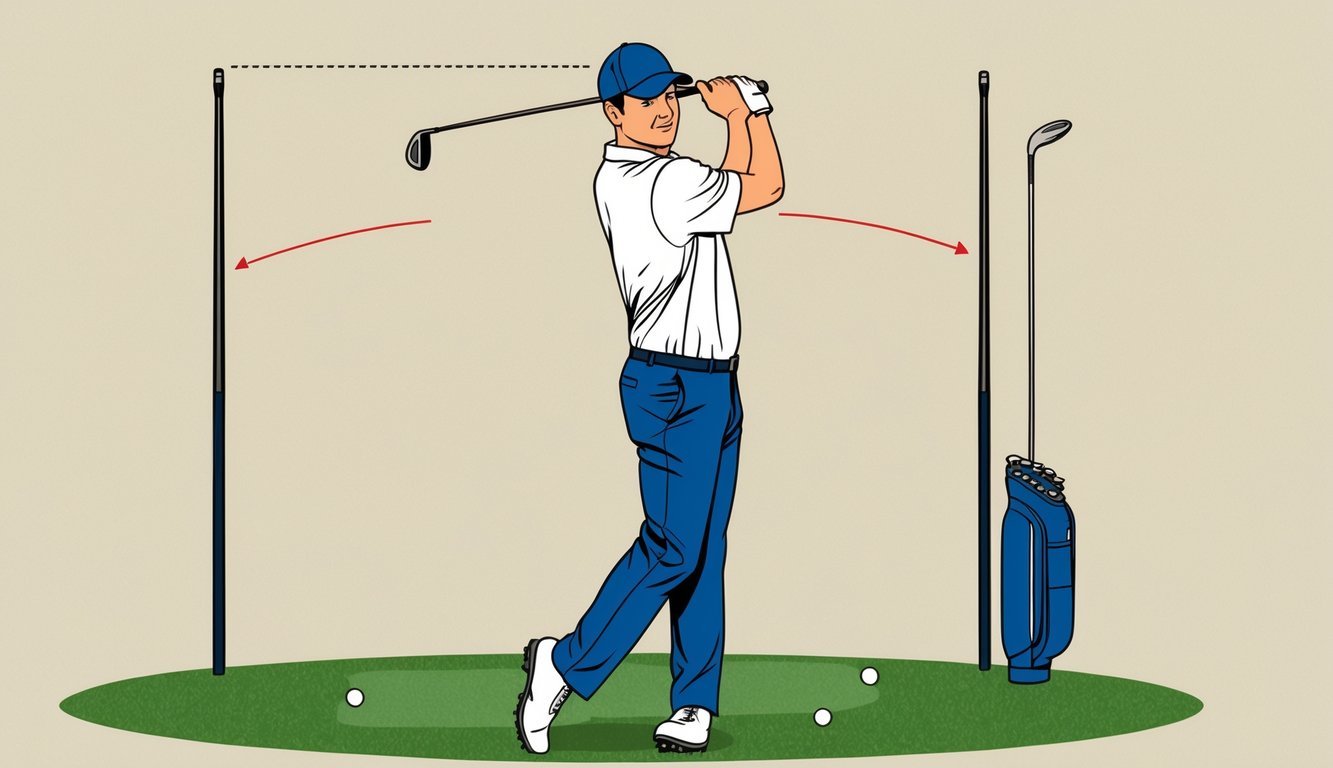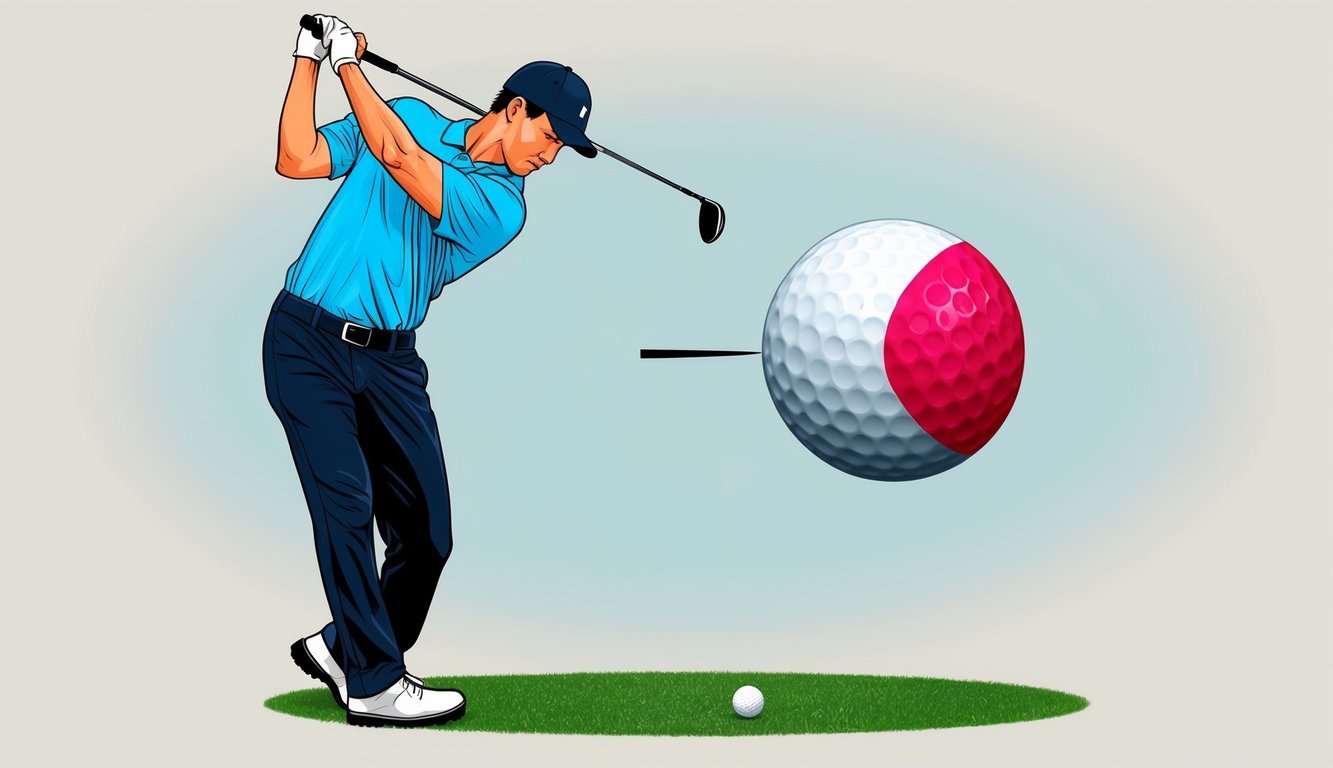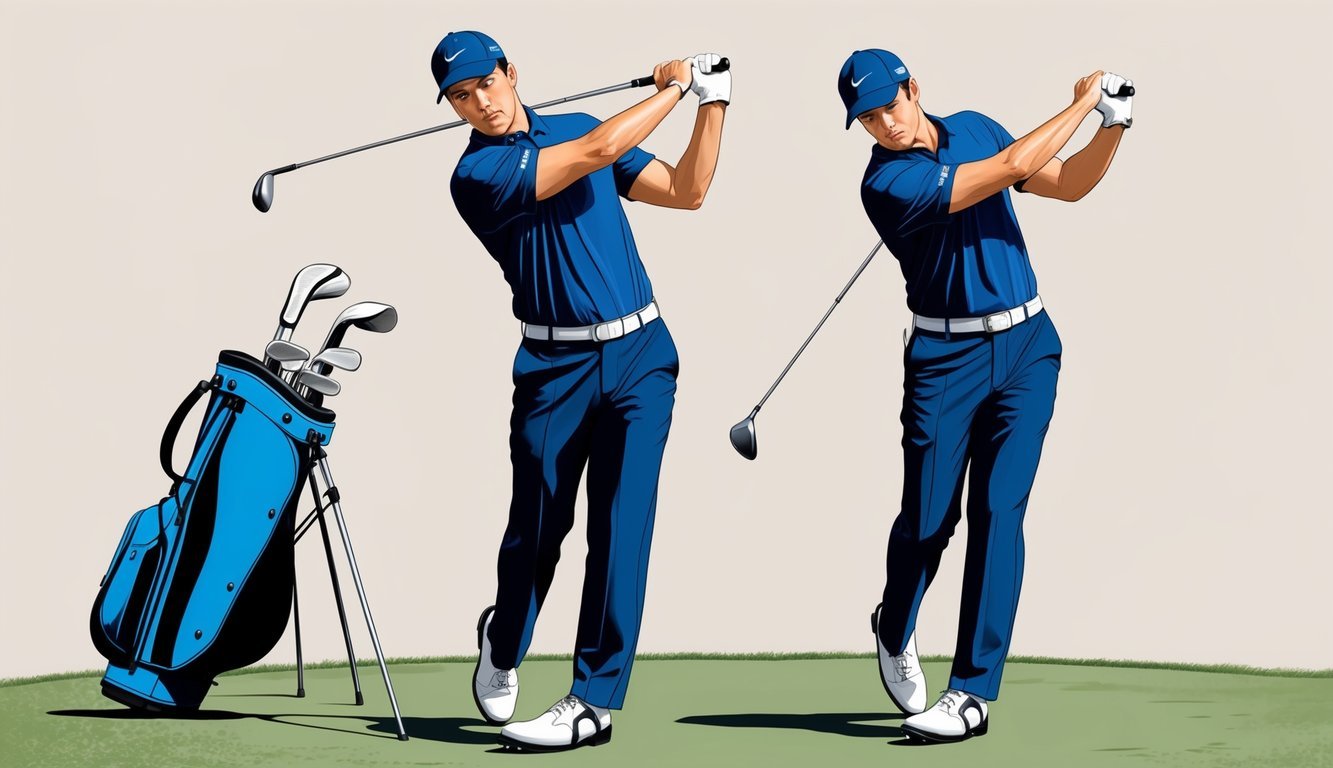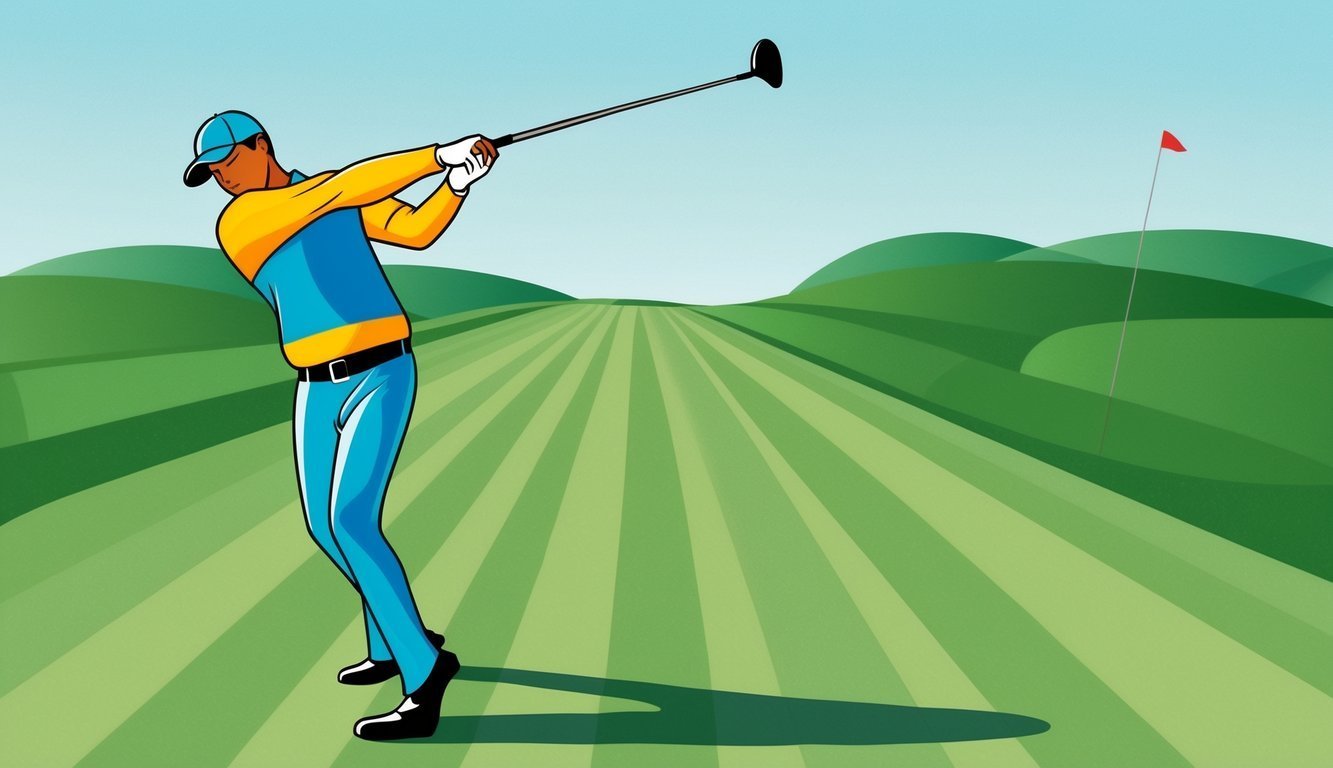Coming over the top is a common issue for many golfers, causing slices and loss of distance.
If you’re struggling with this swing fault, you’re not alone, and there are straightforward methods to fix it. Focusing on your swing’s path and mastering body mechanics is the key to overcoming this.

Improving your golf swing means understanding the reasons behind coming over the top.
By practicing specific drills, you can enhance your swing technique, which will greatly benefit your accuracy and consistency on the course.
Additionally, making tweaks to your equipment might help you find the right balance and control in your swing.
In this article, you’ll discover effective drills and tips to refine your technique, from enhancing your weight shift to maintaining proper club position.
Embarking on this journey will not only improve your swing but also boost your confidence in your game, helping you enjoy playing golf even more.
Key Takeaways
- Correcting swing path reduces slices and improves distance.
- Practicing targeted drills refines swing technique.
- Adjusting equipment can enhance control and performance.
Understanding ‘Over the Top’
The term “over the top” refers to a common swing flaw in golf where the club moves outside the target line during the downswing, leading to various shot issues.
You may experience slices or pulls as a result, affecting both distance and accuracy.
Identifying the Over-the-Top Swing Flaw
Identifying an over-the-top swing involves observing the path of your club during the downswing.
When the clubhead approaches the ball from an outward path, crossing over the intended target line, it’s an indication of this flaw. Check your posture and grip to ensure they aren’t contributing factors.
You might notice slices or pulls, as the misaligned clubface can cause the ball to veer off course.
Practicing with alignment sticks or using video analysis can help identify this issue.
It’s crucial to address it to enhance your swing efficiency and improve shot consistency.
Taking small corrective actions gradually can pave the way for a more controlled swing path.
The Consequences of Coming Over the Top
Coming over the top can lead to a series of problems in your golf game.
One of the most common outcomes is an unintentional slice, where the ball curves dramatically to the right (for right-handed golfers).
This can significantly reduce distance and make it difficult to hit the ball straight consistently.
The swing flaw can also cause pulls, where the ball moves left of the intended target line due to the clubface being closed at impact.
Additionally, inconsistent shots become a major challenge, as correcting the over-the-top motion can help you maintain a steady and reliable swing path.
It’s vital to address these issues to enjoy a more enjoyable and successful time on the course.
Fundamentals of a Proper Golf Swing
Achieving a proper golf swing involves mastering several key elements.
The way you grip the club, align your body, and execute your backswing are integral to enhancing your overall performance on the course.
Grip and Address
Your grip and address set the tone for the entire swing. Grip the club with moderate pressure to maintain control without stiffness.
Ideally, the V created by your thumb and forefinger should point toward your right shoulder if you’re right-handed.
This helps ensure your clubface stays square through impact.
Addressing the ball with proper posture is crucial.
Stand with your feet shoulder-width apart and knees slightly bent.
Lean forward from your hips, keeping your back straight.
Your arms should hang naturally, positioning the club head just behind the ball.
Practice this setup to create a repeatable and balanced starting position.
The Role of Body Alignment
Proper body alignment is vital for a successful golf swing.
Align your feet, hips, and shoulders parallel to the target line.
This setup promotes a straight path for the club and maximizes accuracy.
Consider your posture during your setup; avoid hunching over.
Maintain a slight bend in your knees, and keep your weight balanced between your heels and toes.
This stance provides stability and allows your body to rotate effectively.
Visualize an imaginary line running from the target through your body to help maintain proper alignment throughout the swing.
Backswing Basics
The basics of the backswing lay the foundation for generating power and precision.
Initiate the backswing by turning your shoulders while keeping your lower body stable.
Your hands should remain in front of your chest as the club moves back.
This motion ensures that your swing stays on plane.
Watch your club’s position at the top of the backswing.
Aim to keep it parallel to the ground and in line with your target.
Avoid overextending, as a compact backswing promotes better control and timing.
Practice these fundamentals to develop a smooth and effective transition to your downswing, enhancing the quality and consistency of your performance.
Effective Drills for Correction

Improving your golf swing requires focused practice using specific drills.
These techniques can help you address issues with your swing path and enhance your muscle memory to achieve a more consistent swing.
Drill to Reinforce Muscle Memory
Building muscle memory is crucial for an effective golf swing.
One helpful drill involves using a glove under your arm.
To start, place a glove under your back armpit (right for right-handed golfers).
This drill encourages a more connected swing, helping you avoid the common mistake of arms moving outward.
This movement can often result in cutting across the ball, known as coming over the top.
Practice this regularly to instill the correct form into your muscle memory.
It’s essential to practice this drill consistently on the range.
Video yourself to track progress and make adjustments as needed.
This feedback can solidify your improvements, ensuring that your changes are effective and lasting.
Using Alignment Sticks
Alignment sticks are valuable tools for correcting your swing path.
Set one stick along your target line and another perpendicular to it just outside your back foot.
This setup creates a visual guide for your swing path, aiding in the prevention of coming over the top.
While swinging, focus on maintaining your swing path just above the alignment stick along the target line.
This practice helps reinforce a proper swing path.
Make sure to check your balance during the swing to avoid common pitfalls.
Incorporate these alignment stick drills during your practice sessions to enhance muscle memory.
Use them regularly at the range for the best results.
They provide a clear framework to stay on track, helping you make precise adjustments toward a smoother, more effective swing.
Improving Body Mechanics and Movement

Enhancing your golf swing involves understanding how your body moves and improving the synchronization between different parts.
By focusing on the connection between the upper and lower body and honing hip rotation, you can achieve a more effective and smooth swing.
Syncing the Upper and Lower Body
Synchronization between your upper and lower body is crucial for an efficient golf swing.
Start by paying attention to your stance.
Ensure your feet are shoulder-width apart, allowing a strong base for your swing.
Keep in mind that a well-coordinated movement begins with the lower body leading the downswing.
Focus on generating power through the legs and then letting it flow upwards.
This kinetic chain helps maintain balance and precision.
Practice drills that emphasize weight transfer and body rotation.
An alignment stick can act as a guide to ensure your upper body follows the lead of your lower body effectively.
Additionally, consider incorporating exercises that build core strength.
Strong core muscles support better biomechanics and promote a fluid motion.
Whether working on your drive or putt, a harmonious connection between these two parts helps achieve consistency and improves overall performance.
Developing Hip Rotation
Hip rotation is a pivotal component in avoiding the common ‘coming over the top’ error.
To develop effective hip rotation, focus on initiating your swing with your hips followed by your shoulders.
This sequence helps prevent the upper body from taking control too soon.
Visualize your hips leading the turn and bringing your shoulders naturally into place.
Practicing with a glove under your arm can ensure the right motion is maintained as you swing.
Exercises that enhance flexibility and mobility in your hips are beneficial, particularly dynamic stretches and resistance training.
Maintaining a strong posture throughout the swing allows your hips to engage more effectively.
As your comfort with correct hip movement increases, you’ll likely notice an improvement in the accuracy and distance of your shots, leading to a more satisfying game.
Adjusting Equipment for Better Swing

Making small adjustments to your golf equipment can have a significant impact on your swing technique.
Consider evaluating each piece, from your driver to your irons, to ensure they complement your swing style.
If you often come over the top, you might want to assess your golf club.
Using impact tape can help pinpoint where your clubface makes contact with the ball.
This provides valuable insight into how well your club is aligned.
For your driver, adjusting the loft or the club’s setting might assist in achieving a more optimal swing path.
An incorrectly fitted driver can lead to slices.
Visit a professional fitter to ensure your driver is suited to your needs.
When it comes to irons, selecting the right shaft is essential.
A shaft that doesn’t match your swing speed can exacerbate issues.
Lighter or more flexible shafts may help in achieving better control and reduce the tendency to swing over the top.
Pay attention to the clubface alignment.
Ensuring it is square at address can prevent unintentional alterations in your swing path.
If needed, seek a professional’s advice for adjustments.
Lastly, remember that even the golf ball you choose can influence your swing.
Different balls have varying spin rates and compressions, serving different swing types.
Experiment with a few to see which one complements your adjustments.

